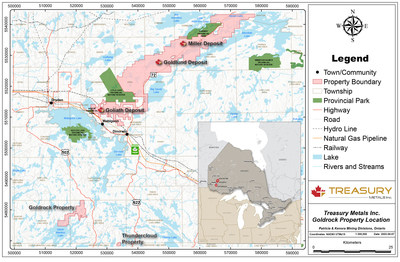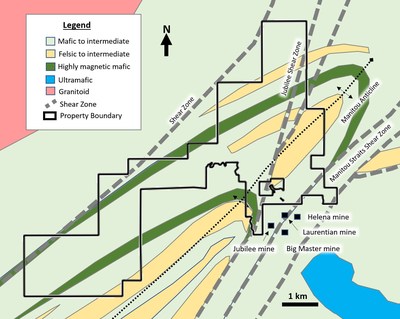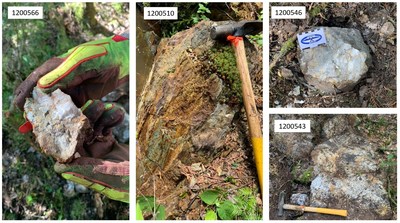Highlights:
- Completion of prospecting program on Goldrock Property South of Dryden.
- Upcoming Airborne geophysical survey to be completed on property in the next month.
TSX: TML OTCQX: TSRMF
TORONTO, Sept. 13, 2022 /CNW/ - Treasury Metals Inc. (TSX: TML) (OTCQX: TSRMF) (“Treasury” or the “Company”) is pleased to announce the completion of a prospecting program at the 100% owned Goldrock Property (“Goldrock”) located approximately 30 km south of the city of Dryden in Northwestern Ontario, approximately 40 km southwest of the Company’s Goliath Gold Complex. The Company will follow up this prospecting campaign with an airborne geophysical survey starting late September.
Jeremy Wyeth, President and CEO of Treasury Metals, commented: “Our Exploration strategy for 2022 has been to assess our regional land package for further opportunities. These early-stage exploration campaigns, such as what we have just completed at Goldrock fit into that strategy well. The geological team has been working on a wholistic review of the area to better understand how the deposits were formed and where to find more of them. We are excited about the progress from the early-stage prospecting and look forward to the results from the geophysics work later this year for potential additional prospective targets.”
The Goldrock Property is located in the historic Goldrock Mining Camp which is hosted in the Eagle-Wabigoon-Manitou Lakes greenstone belt. The property covers the Manitou anticline which is a large-scale regional fold adjacent to the Manitou Straits Shear Zone (Figure 2). Regional folds often act as excellent traps for gold mineralization. Shear zones or faults act as fluid conduits for mineralizing fluids during the formation of gold deposits. The Manitou Straits Shear Zone is interpreted to be approximately 4-5 km wide composed of anastomosing discrete shear zones that trend northeast through the Goldrock Mining Camp. Mapping had shown additional shear zones running through the Goldrock Property. Several historic mines are located proximal to the regional shear zone structures and historic test pits and shafts are located throughout the area.
Treasury conducted prospecting and mapping at the Goldrock Property during the summer of 2022. Sixty-two samples were collected for geochemical analysis, all samples will be analyzed for gold and 4-acid near total digestion ICP, while representative (less altered and deformed) samples will undergo whole-rock geochemistry. The geochemical alterations will be compared to the Goliath and Goldlund deposits and other greenstone hosted gold deposits to look for path finder elements and trends.
The prospecting team encountered favourable mineralization and veining in outcrops at Goldrock. Historically, mineralization in the Goldrock camp has been associated with quartz-veining in mafic to intermediate volcanic rocks within the shear zone footprint. In addition, sheared and altered volcanic rocks with sulphide mineralization (predominantly pyrite) has been associated with gold mineralization. The Treasury team encountered several locations with volcanics hosting up to metre-wide quartz veining with abundant euhedral pyrite mineralization (Figure 3). The areas with the most extensive shearing also showed strong silicification alteration with sulphide mineralization.
The new mapping coupled with the detailed airborne geophysical survey will help to define the location and intensity of the anastomosing shear zones within the property. Historic mines have been located proximal to shear zones, therefore identification of the shear zones on the property will be a key exploration vector (Figure 2). The airborne geophysical survey planned for later this month will be helpful for defining these shear zones across the property where outcrops are not prevalent.
The Company will be flying an Airborne Geophysical program starting in late September which will include digital line profile data, electromagnetic and magnetic survey. Treasury will be running a NRGTM (New Resolution Geophysics) Xcite TDEM system, this provides a superior and efficient alternative to all prior HTDEM technologies for the mineral exploration community. The NRGTM has developed a proprietary algorithm which allows the magnetic sensor to be mounted on the EM transmitter loop. This configuration ensures the magnetic sensor is close to the geological source improving the source to noise ratio. The key for explorers being that there is an improved definition on geological anomalies. Following the geophysical survey, the Company will begin a regional geological interpretation for Goldrock which integrates the new datasets for exploration targeting.
QA / QC
The Company has implemented a quality assurance and quality control (QA/QC) program to ensure sampling and analysis of all exploration work is conducted in accordance with the CIM Exploration Best Practices Guidelines. The drill core is sawn in half with one-half of the core sample dispatched to Activation Laboratories Ltd. facility located in Dryden, Ontario. The other half of the core is retained for future assay verification and/or metallurgical testing. Other QA/QC procedures include the insertion of blanks and Canadian Reference Standards for every tenth sample in the sample stream. A quarter core duplicate is assayed every 20th sample. The laboratory has its own QA/QC protocols running standards and blanks with duplicate samples in each batch stream. Additional checks are routinely run on anomalous values including gravimetric analysis and pulp metallic screen fire assays. Gold analysis is conducted by lead collection, fire assay with atomic absorption and/or gravimetric finish on a 50-gram sample. Check assays are conducted at a secondary ISO certified laboratory (in this case AGAT Laboratories located in Mississauga, Ontario) following the completion of a program.
Qualified Persons
Maura Kolb, M.Sc., P.Geo., Director of Exploration and Adam Larsen, P. Geo., Exploration Manager, are both considered as a “Qualified Person” for the purposes of National Instrument 43-101 Standards of Disclosure for Mineral Projects (“NI 43-101”), and have reviewed and approved the scientific and technical disclosure contained in this news release on behalf of Treasury.
About Treasury Metals Inc.
Treasury Metals Inc. is a gold focused company with assets in Canada. Treasury’s Goliath Gold Complex, which includes the Goliath, Goldlund and Miller deposits, is located in Northwestern Ontario. The deposits benefit substantially from excellent access to the Trans-Canada Highway, related power and rail infrastructure, and close proximity to several communities including Dryden, Ontario. The Company also owns several other projects throughout Canada, including the Lara Polymetallic Project, Weebigee-Sandy Lake Gold Project JV, and grassroots gold exploration property Gold Rock. Treasury Metals is committed to inclusive, informed and meaningful dialogue with regional communities and Indigenous Nations throughout the life of all our Projects and on all aspects, including: creating sustainable economic opportunities, providing safe workplaces, enhancing of social value, and promoting community well-being.
For information on the Goliath Gold Complex, please refer to the preliminary economic assessment, prepared in accordance with NI43‑101, entitled “NI 43‐101 Technical Report & Preliminary Economic Assessment of the Goliath Gold Complex: and dated March 10, 2021 with an effective date of January 28, 2021, led by independent consultants Ausenco Engineering Canada Inc. The technical report is available on SEDAR at www.sedar.com, on the OTCQX at www.otcmarkets.com and on the Company website at www.treasurymetals.com.
To view further details about Treasury, please visit the Company’s website at www.treasurymetals.com.
Neither the TSX nor its Regulation Services Provider (as that term is defined in the policies of the TSX) accepts responsibility for the adequacy or accuracy of this release.
Forward-Looking Statements
This release includes certain statements that may be deemed to be “forward-looking statements”. All statements in this release, other than statements of historical facts, that address events or developments that management of the Company expect, are forward-looking statements. Forward-looking statements are frequently, but not always, identified by words such as “expects”, “anticipates”, “believes”, “plans”, “projects”, “intends”, “estimates”, “envisages”, “potential”, “possible”, “strategy”, “goals”, “objectives”, or variations thereof or stating that certain actions, events or results “may”, “could”, “would”, “might” or “will” be taken, occur or be achieved, or the negative of any of these terms and similar expressions. Actual results or developments may differ materially from those in forward-looking statements. Treasury disclaims any intention or obligation to update or revise any forward-looking statements, whether as a result of new information, future events or otherwise, save and except as may be required by applicable securities laws.
Since forward-looking information address future events and conditions, by their very nature they involve inherent risks and uncertainties. Actual results could differ materially from those currently anticipated due to a number of factors and risks. These include, but are not limited to, exploration and production for precious metals; delays or changes in plans with respect to exploration or development projects or capital expenditures; the uncertainty of resource estimates; health, safety and environmental risks; worldwide demand for gold and base metals; gold price and other commodity price and exchange rate fluctuations; environmental risks; competition; incorrect assessment of the value of acquisitions; ability to access sufficient capital from internal and external sources; and changes in legislation, including but not limited to tax laws, royalties and environmental regulations.
Actual results, performance or achievement could differ materially from those expressed in, or implied by, the forward-looking information and, accordingly, no assurance can be given that any of the events anticipated by the forward-looking information will transpire or occur, or if any of them do so, what benefits may be derived therefrom and accordingly, readers are cautioned not to place undue reliance on the forward-looking information.
Note to United States Investors
All resource estimates included in this press release have been prepared in accordance with Canadian standards, which differ in some respects from United States standards. In particular, and without limiting the generality of the foregoing, the terms “inferred mineral resources,” “indicated mineral resources,” “measured mineral resources” and “mineral resources” that may be used or referenced are Canadian mining terms as defined in accordance with National Instrument 43 101 – Standards of Disclosure for Mineral Projects under the guidelines set out in the Canadian Institute of Mining, Metallurgy and Petroleum (the “CIM”) Standards on Mineral Resources and Mineral Reserves (the “CIM Standards”). The CIM Standards differ significantly from standards in the United States. While the terms “mineral resource,” “measured mineral resources,” “indicated mineral resources,” and “inferred mineral resources” are recognized and required by Canadian regulations, they are not defined terms under standards in the United States. “Inferred mineral resources” have a great amount of uncertainty as to their existence, and great uncertainty as to their economic and legal feasibility. It cannot be assumed that all or any part of an inferred mineral resource will ever be upgraded to a higher category. Under Canadian securities laws, estimates of inferred mineral resources may not form the basis of feasibility or other economic studies. Readers are cautioned not to assume that all or any part of measured or indicated mineral resources will ever be converted into reserves. Readers are also cautioned not to assume that all or any part of an inferred mineral resource exists or is economically or legally mineable. Disclosure of “contained ounces” in a resource is permitted disclosure under Canadian regulations; however, United States companies are only permitted to report mineralization that does not constitute “reserves” by standards in the United States as in place tonnage and grade without reference to unit measures. Accordingly, information regarding resources contained or referenced in this [name of disclosure document] containing descriptions of our mineral deposits may not be comparable to similar information made public by United States companies.
SOURCE Treasury Metals Inc.

Contact
Jeremy Wyeth, President & CEO, T: +1 416 214 4654; Orin Baranowsky, CFO, T: +1 416 214 4654, Email: info@treasurymetals.com, Twitter @TreasuryMetals



